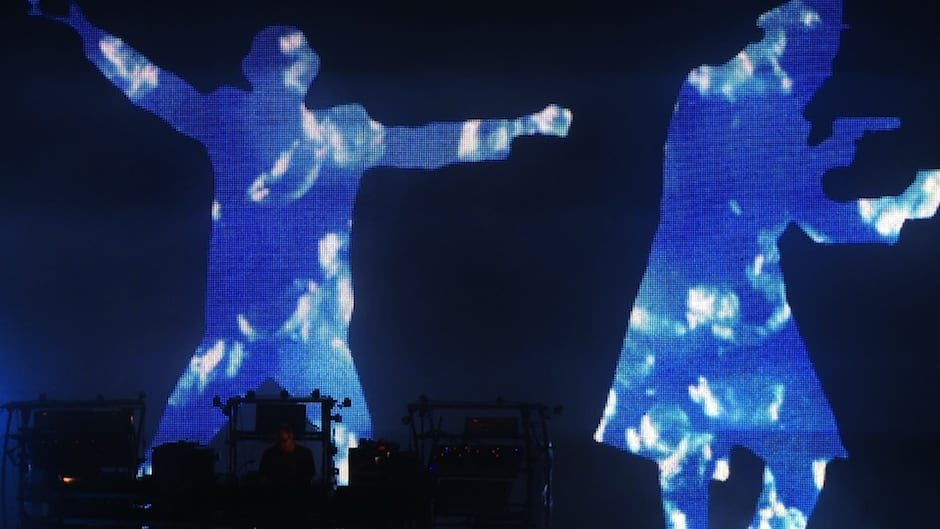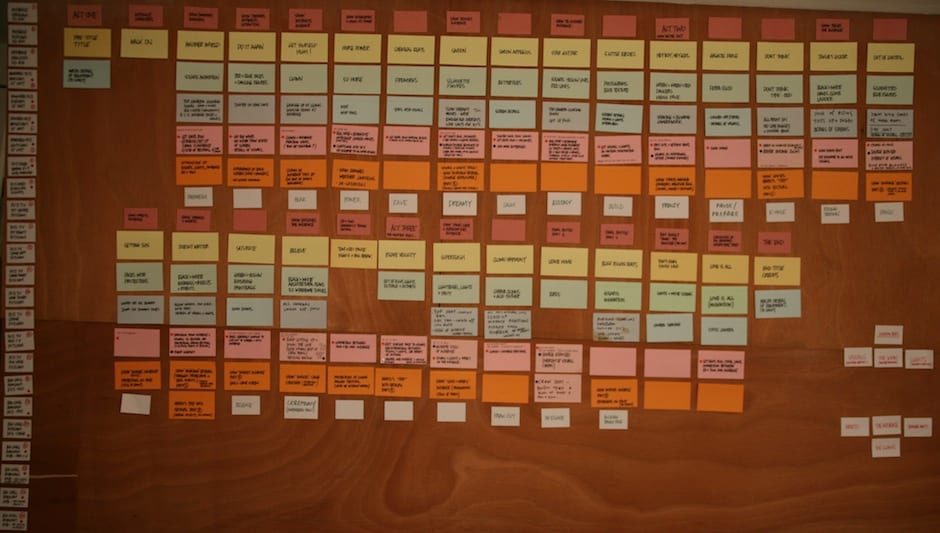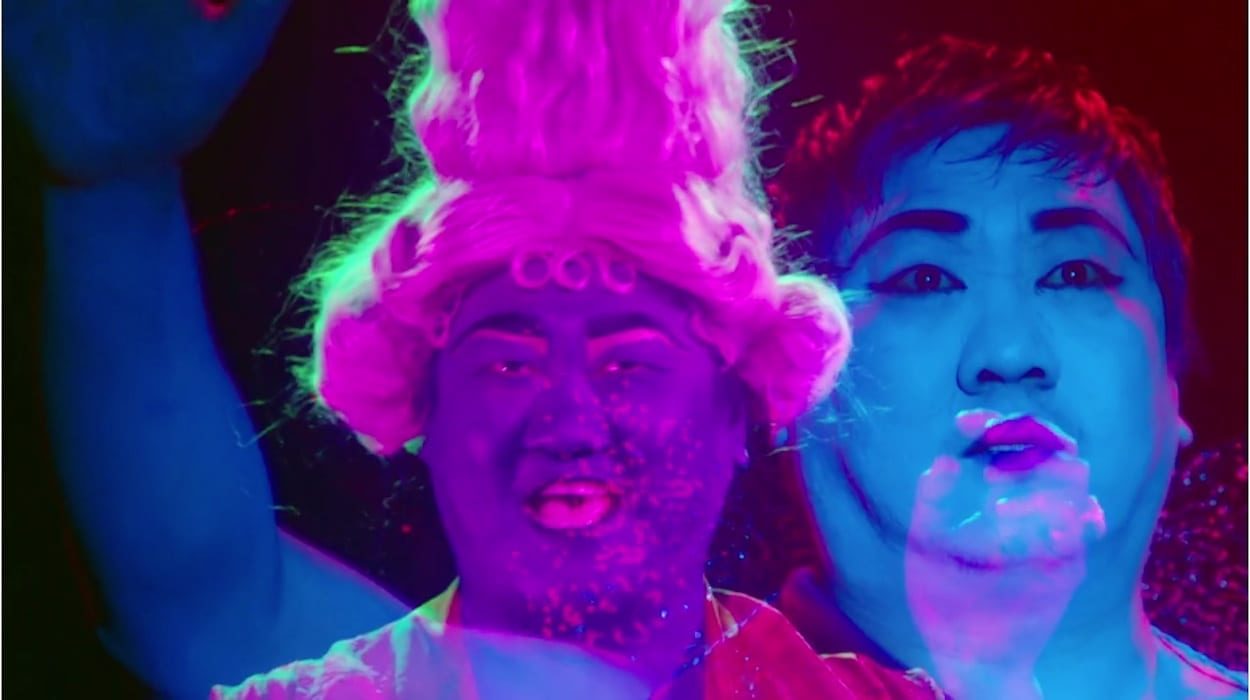RSA/Black Dog director Adam Smith and producer Marcus Lyall of ML Studio have been creating visuals for the Chemical Brothers since the days of slide projectors and black and white images when the band played small clubs. It’s been a synergetic relationship that has evolved into epic live performances where Tom Rowlands and Ed Simons play in silhouette allowing the light shows and visuals to take centre stage.
We talk with Smith and Lyall about creating the projections and the making of the spectacular rollercoaster film of the Chemical Brothers concert at Fuji Rocks, called Don’t Think, which opened this month in 600 cinemas worldwide.
If you weren’t one of the crowd surfing dancing audience at one of the launch screenings, (check out future screenings here), the DVD and Blu-Ray will be released late March along with a 10” limited edition book. Just make sure you get a projector, a large screen, huge speakers and a party together.
Adam, how did your relationship working with the Chemical Brothers come about?
It’s the longest relationship I’ve ever had and the longest job I’ve ever had too. We met just being out and about 18 years ago. I was working with a guy called Noah Clark doing visuals and we were known as Vegetable Vision.
The Chemical Brothers were DJ-ing at clubs and they asked us to do some visuals at their first live show. It was very Heath Robinson-meets-70s-AV-show. We used two slide projectors with black-and-white images and strange wheels that we had made to go in front of the projector using a Hornby controller to control their speed.
We were very much against using video projectors then and I think because we were an analogue show that appealed to Tom and Ed as they were using analogue synths. The set was 20 minutes long.
Now it takes three or four trucks and 20 to 30 crew to put the show together but back then it was me, Noah, Ed and Tom and a tour manager who on this first gig out of London turned up not with the van we were expecting but an ice-cream van so we stuffed the equipment in with the cornettos and off we went.
Noah and I did progress to a scaffolding tower with 17 Xenon projectors and 16mm loops of film around our necks frantically adjusting machines and changing loops. It was very bad performance art.
Is each performance different?
Marcus: The actual set list is pretty much the same for every show but they are effectively remixing their entire set throughout each live performance, that’s what they do as musicians.
On set there’s a lighting designer who is pushing buttons and going with the vibe of what Tom and Ed are doing. They may play the same tracks whether it’s in a dark, up-for-it club or at a festival, but there will be more black outs and in-your-face edgy lighting in a club, whereas if it’s a festival you have to reach out to a crowd of 30 to 40 thousand people so the lighting guys are making that happen but all the intricate programming was done in advance.
The Chemical Brothers are steering if you like, but the audience is watching reactive audio-visual theatre.
How does the creative process for the visuals work?
Adam: The music is the starting point always and the set list is like the script. For instance, Marcus will say something like I found this stuff called Ferrofluid and we should do something with that for this particular song, but it’s different for each song… we are also trying to keep a human element to get an emotional connection with the audience. That really comes into the film as the audience is a massive part of it.
Marcus: There’s a backlog of 15 years of visual material so it’s always a fusion of existing and new stuff.
The visuals may look very high-tech but we try to create them in a hand crafted way. For instance you see this figure that looks like it’s done in 3D software but it’s a bloke dancing out of focus in a black lycra gimp suit with little LEDS sewn into it.
There’s always a nod to mid-20th century experimental film making like Len Lyes, Norman McLaren, Lotte Reiniger, all those abstract experiments particularly with silhouettes that Adam and I watched as students and thought were fantastic.
The work flow chart for the film on the wall is like a giant rectangular mind map…
Adam: Well it’s all so big and if I try to think of the whole thing my head explodes. I’m a list’oholic so it’s like writing a list and doing those cards is the ignition switch. Then you start moving them around and you can see it. It also helps to know where we are in the film – ok that happened there. It’s also a very good procrastination process, I need to spend hours and hours doing very neat cards, it means I don’t have to commit to any decisions or talk to anyone at this point.
But it’s getting to know something so well, then you come to the shoot and of course it doesn’t go according to plan…
That’s the exciting thing, but this wall is like a storyboard, it’s a safety net. It is like an actor who knows their lines forwards, backwards and sideways and that allows them to be in the moment and express themselves without thinking, without using the analytical mind. It’s like spewing all that stuff out, learning it, and being free to try other things, because some other part of the brain knows that we’ve got that covered by something else if it doesn’t work. Don’t Think is a good title for the film because we tried to work on an instinctive level as much as possible. If you start over analyzing, dwelling on why there’s a cloud bathed in light with a father saying you are all more children now, you might get into some dangerous territory.
There is a narration through the film, an emotional journey?
Adam: Yes that’s what I mean about the music being a script, is that the set takes you on an emotional journey, it’s not a normal narrative like someone needs something and there’re obstacles and they either get it or don’t and they learn something about themselves at the end, it’s an emotional journey through joy, euphoria, pain, fear and we try and push that even further. A lot of the Chemical Brothers music is dark, it’s sinister and scary and that’s why it’s amazing to work with them, and then it can be euphoric with lovely messages in there like ‘Just remember to fall in love’ and ‘Don’t think just let it flow’ which are all nice sentiments but on that journey of finding things out sometimes it’s scary and sometimes horrible things can happen.
Why was the decision to make the film now?
Marcus: This show had been touring for six months before the Fuji Rock Festival so by then it had built up a head of steam and it was at a point where Tom and Ed and the crew were comfortable how the show worked dynamically.
This tour is the new album mixed with older tracks and some new unreleased stuff as well. Whereas the album was more conceptual the tour was designed to be more of a festival massive dancing set. I think they thought that we really got to get this down, this is one of those things when all the planets have all aligned, the stage production is really working and musically it works and the visuals were evolved, let’s have it, let’s document this moment. And that’s how the film came about.
LINKS:
















